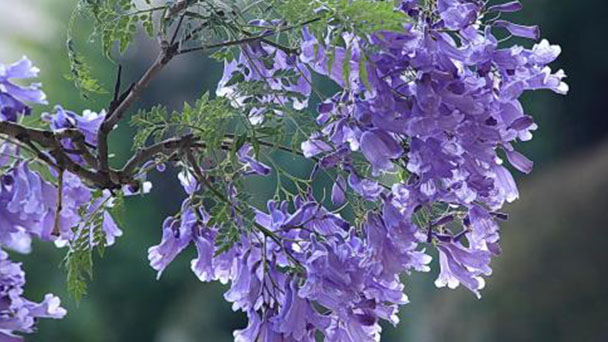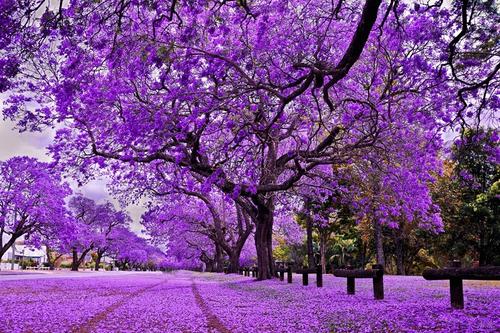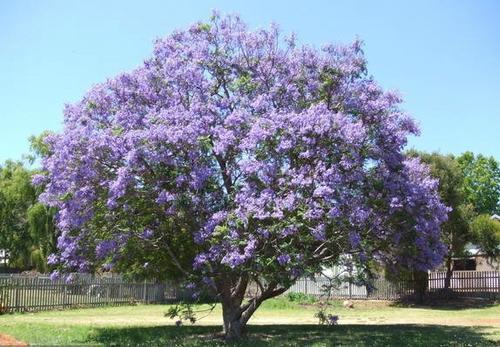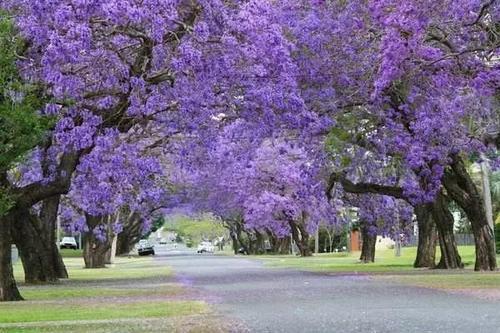Blue Jacaranda profile
Written by Maggie
Sep 11 2021

Blue Jacaranda, scientific name Jacaranda mimosifolia belongs to the genus Blue Jacaranda of Vladivoeaceae. Mainly distributed in Argentina, Bolivia, Brazil and other South American regions, in recent years, it has been successfully introduced to China, Guangxi, Hainan, Guangdong, Yunnan, Fujian and other places have been distributed. Flower language: in despair waiting for love.
Blue Jacaranda picture

Morphological characteristics of Blue Jacaranda
Blue Jacaranda ( Jacaranda mimosifolia) has a tall canopy of 13-14 meters and can reach a maximum of 20 meters. Leaves are opposite, odd leaflets. There are white, pink, blue, purple, red, with the most beautiful lavender. Corolla is purplish blue, when flowering, clusters of purplish blue, the flowers are dense, lip shaped, about 5 cm long, flowers bloom twice a year, the first from early May, in mid-June to the peak, finally in early July; The second bloom begins in late August and ends in mid-October. Fruit is a capsule, round slightly oblate, light brown, ca. 5 cm in diameter.
Blue Jacaranda growth habit
Blue Jacaranda ( Jacaranda mimosifolia) likes warm climates and should be planted in sunny places. The requirements of soil conditions are not strict, in general neutral and slightly acidic soil can grow. blue jacaranda is drought resistant, not cold resistant. Because the root system is shallow and not wind resistant, it is not recommended to plant in typhoon areas.
Blue Jacaranda distribution range
Blue Jacaranda ( Jacaranda mimosifolia) is native to South America Brazil, Bolivia, Argentina. China Guangdong (Guangzhou), Hainan, Guangxi, Fujian, south Yunnan (Xishuangbanna) cultivation for garden ornamental.
Propagation Blue Jacaranda
There are three methods of propagation in Blue Jacaranda: Seeding, cuttage and tissue culture.
Cutting propagation
Cuttage propagation Blue Jacaranda ( Jacaranda mimosifolia) is mainly distributed in the spring and autumn of each year, cutting propagation to choose Blue Jacaranda growth more robust strips as cuttings, which will improve the survival rate of Blue Jacaranda.
Seed propagation
The fruits of Blue Jacaranda are mainly ripened around November every year. After picking the fruits of Blue Jacaranda, we should pay attention to exposing them to the sun in a place without wind, and store them after the seeds are dried. The suitable sowing time for Blue Jacaranda is around March each year.
Tissue culture propagation
Tissue culture propagation of Blue Jacaranda is relatively easy. Some scientific research institutions in China have adopted the method of tissue culture to cultivate a large number of Blue Jacaranda in vitro seedlings.

Cultivation techniques of Blue Jacaranda
The temperature
Blue Jacaranda ( Jacaranda mimosifolia) is originally a plant growing in America. It grows in a warm and humid environment, which determines that Blue Jacaranda prefers warm and humid environments by nature.
The suitable growth temperature is 22℃~30℃. When the temperature is lower than 15℃ in winter, the growth stagnates. If it is below 3℃~5℃, there is a risk of freezing. Blue Jacaranda is not resistant to frost and snow, so remember to control the temperature in winter. The growth was inhibited when the temperature was higher than 32℃ in summer.
Light
Blue Jacaranda likes light by nature, so it is best to put Blue Jacaranda in a sunny place. However, Blue Jacaranda can withstand semi-shade. When the summer sun is too strong, shade should be appropriate.
Soil
Blue Jacaranda prefers rich, moist sandy or loam soil, so be careful when planting
Fertilization
Trim
Pruning and pruning once a year in early spring, and repruning old plants.
Blue Jacaranda Main Value
1. Ornamental value of gardens
As a deciduous tree, Blue Jacaranda ( Jacaranda mimosifolia) is very rare in China. Therefore, Blue Jacaranda can be used as a street tree, shade tree and landscape tree in China. The flowers of Blue Jacaranda in flowering season are very beautiful, so Blue Jacaranda is indeed a precious plant.
2. Economic value
Apart from its landscape value, Blue Jacaranda also has certain economic value. Blue Jacaranda can be used to make paper. The initial whiteness of Blue Jacaranda wood powder was lower, but the lignin content was higher, and the extract content in Blue Jacaranda solvent was comparable to that of broad-leaved wood. It has short fibers and a relatively low basic density. The wood is soft and light, and can be used as furniture.

Latest Updated
- Benefits of Bugleweed - 7 Science-backed Health Benefits
- Bugleweed Dangers & Side Effects - Is It Poisonous?
- How to Plant Evergreen Trees - What You Should Know
- When to Plant Evergreens - Grow Guide for Evergreen Trees
- 12 Wonderful Evergreen Shrubs for Your Garden
- 12 Popular Evergreen Plants with Pictures for Beginners
- When And How To Prune A Lilac Bush Like a Pro
- How to Grow & Care for Lilac Vine (Hardenbergia Violacea)
- Japanese Lilac Tree (Syringa Reticulata) Care & Propagation Guide
- Shumard Oak Pros and Cons - What to Know
Popular Articles
- Winter maintenance of Antirrhinum Majus
- How to Grow Terminalia Mantaly Tree
- How to Grow and Care for Crossostephium Chinense
- How to grow Antirrhinum Majus in spring
- Peristeria Elata (Dove Orchid) Profile: Info & Care Guide
- Underwatered Snake Plant (Sansevieria Trifasciata) - Signs And How To Fix
- How to Care for Brazilian Jasmine Plant (Mandevilla Sanderi)
- How to Grow & Care for Graptopetalum Purple Delight in Summer
- Rosa Chinensis (China Rose): Plant Growing & Care Tips
- How to Care for Baby Sun Rose (Aptenia Cordifolia)